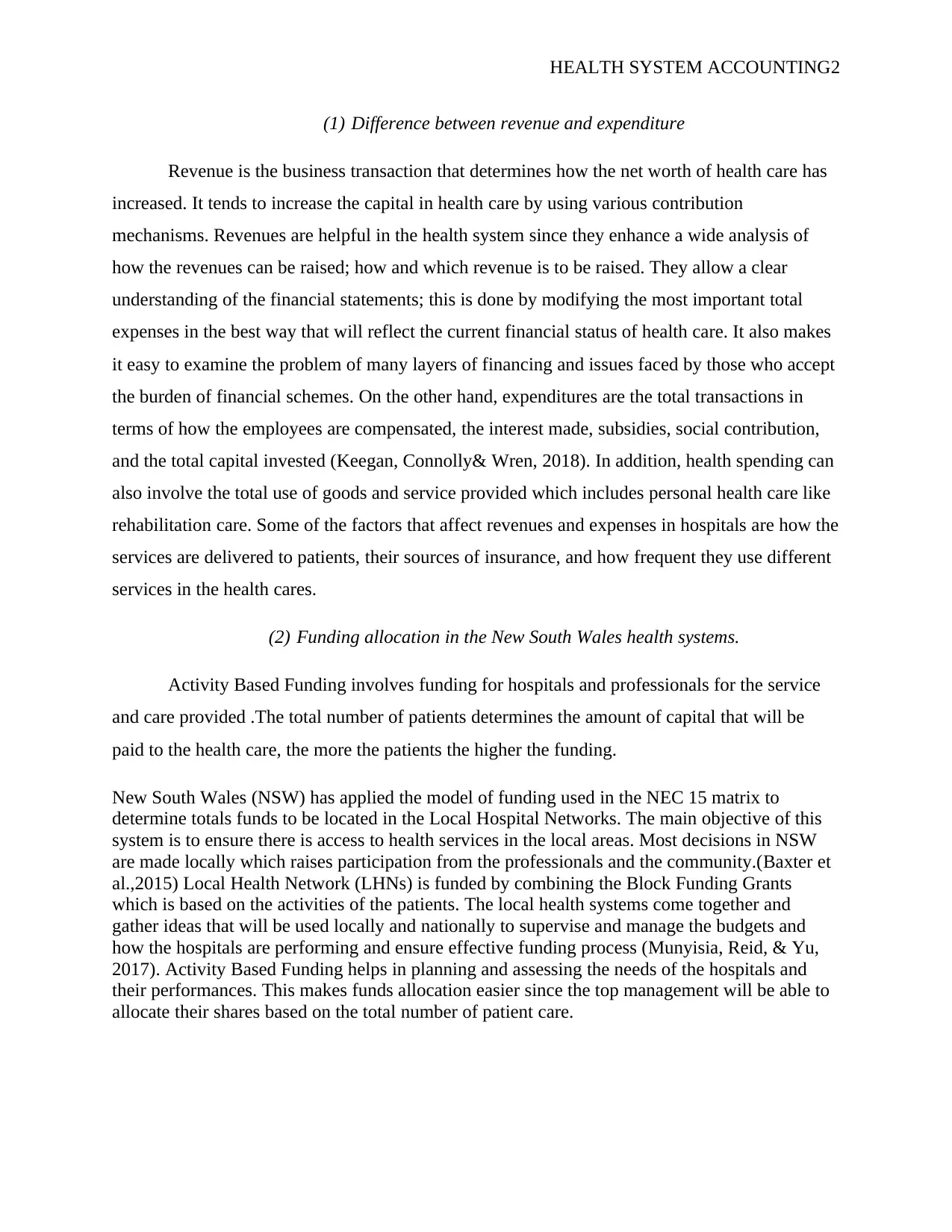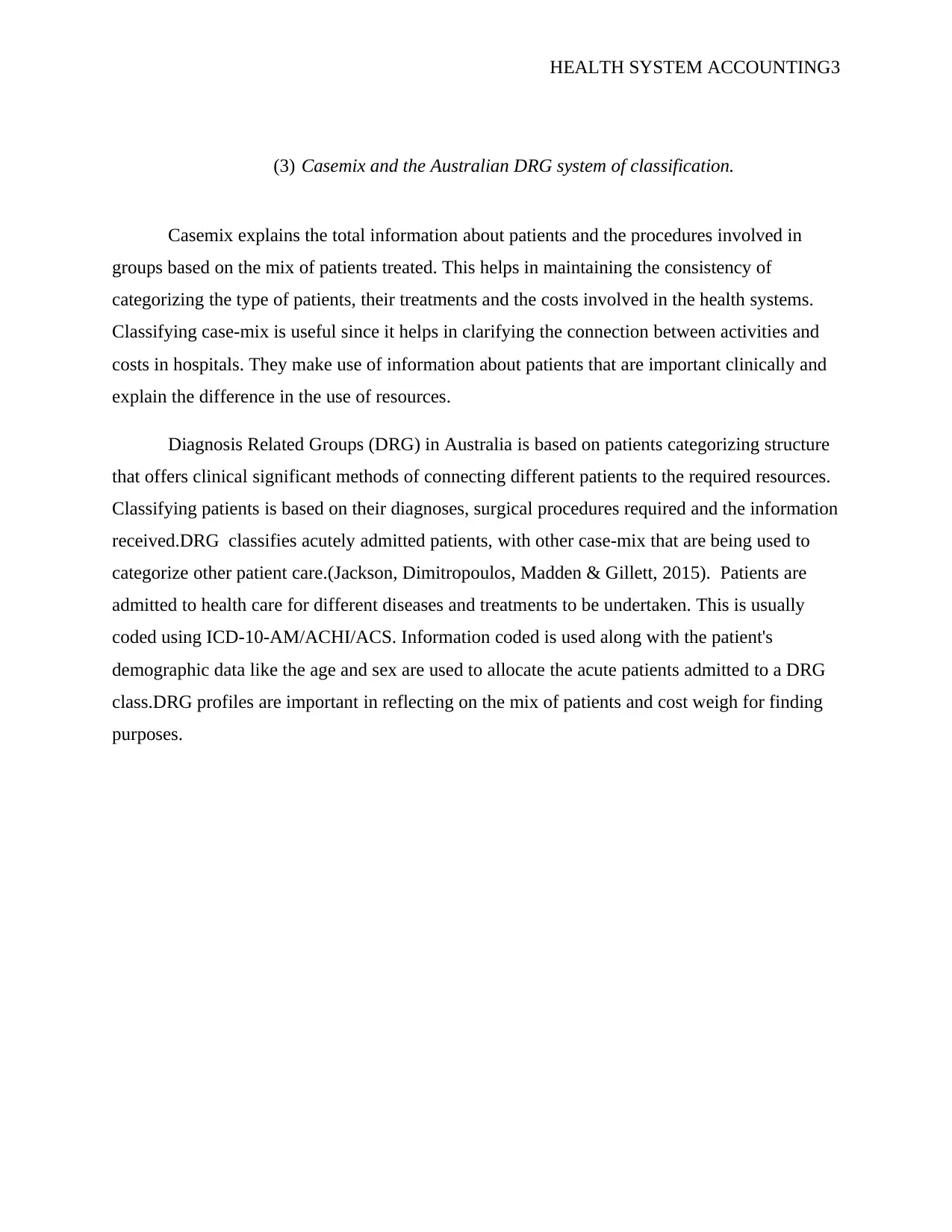Health System Accounting Assignment - Financial Processes and Issues
VerifiedAdded on 2023/01/16
|4
|934
|83
Homework Assignment
AI Summary
This assignment solution addresses key concepts in health system accounting, including the difference between revenue and expenditure, funding allocation within the New South Wales (NSW) health system, and the Casemix and Australian Diagnosis Related Groups (DRG) system. The solution explains how revenue increases capital, the factors affecting revenues and expenses in hospitals, and the Activity Based Funding model used in NSW. It also details the Casemix classification and the role of DRGs in categorizing patients for resource allocation. The assignment uses APA referencing and provides concise answers to the questions, demonstrating an understanding of financial management processes and current issues in healthcare.

Running head: HEALTH SYSTEM ACCOUNTING 1
Health system accounting
Students name:
Course number:
University-affiliated:
Date:
Health system accounting
Students name:
Course number:
University-affiliated:
Date:
Paraphrase This Document
Need a fresh take? Get an instant paraphrase of this document with our AI Paraphraser

HEALTH SYSTEM ACCOUNTING2
(1) Difference between revenue and expenditure
Revenue is the business transaction that determines how the net worth of health care has
increased. It tends to increase the capital in health care by using various contribution
mechanisms. Revenues are helpful in the health system since they enhance a wide analysis of
how the revenues can be raised; how and which revenue is to be raised. They allow a clear
understanding of the financial statements; this is done by modifying the most important total
expenses in the best way that will reflect the current financial status of health care. It also makes
it easy to examine the problem of many layers of financing and issues faced by those who accept
the burden of financial schemes. On the other hand, expenditures are the total transactions in
terms of how the employees are compensated, the interest made, subsidies, social contribution,
and the total capital invested (Keegan, Connolly& Wren, 2018). In addition, health spending can
also involve the total use of goods and service provided which includes personal health care like
rehabilitation care. Some of the factors that affect revenues and expenses in hospitals are how the
services are delivered to patients, their sources of insurance, and how frequent they use different
services in the health cares.
(2) Funding allocation in the New South Wales health systems.
Activity Based Funding involves funding for hospitals and professionals for the service
and care provided .The total number of patients determines the amount of capital that will be
paid to the health care, the more the patients the higher the funding.
New South Wales (NSW) has applied the model of funding used in the NEC 15 matrix to
determine totals funds to be located in the Local Hospital Networks. The main objective of this
system is to ensure there is access to health services in the local areas. Most decisions in NSW
are made locally which raises participation from the professionals and the community.(Baxter et
al.,2015) Local Health Network (LHNs) is funded by combining the Block Funding Grants
which is based on the activities of the patients. The local health systems come together and
gather ideas that will be used locally and nationally to supervise and manage the budgets and
how the hospitals are performing and ensure effective funding process (Munyisia, Reid, & Yu,
2017). Activity Based Funding helps in planning and assessing the needs of the hospitals and
their performances. This makes funds allocation easier since the top management will be able to
allocate their shares based on the total number of patient care.
(1) Difference between revenue and expenditure
Revenue is the business transaction that determines how the net worth of health care has
increased. It tends to increase the capital in health care by using various contribution
mechanisms. Revenues are helpful in the health system since they enhance a wide analysis of
how the revenues can be raised; how and which revenue is to be raised. They allow a clear
understanding of the financial statements; this is done by modifying the most important total
expenses in the best way that will reflect the current financial status of health care. It also makes
it easy to examine the problem of many layers of financing and issues faced by those who accept
the burden of financial schemes. On the other hand, expenditures are the total transactions in
terms of how the employees are compensated, the interest made, subsidies, social contribution,
and the total capital invested (Keegan, Connolly& Wren, 2018). In addition, health spending can
also involve the total use of goods and service provided which includes personal health care like
rehabilitation care. Some of the factors that affect revenues and expenses in hospitals are how the
services are delivered to patients, their sources of insurance, and how frequent they use different
services in the health cares.
(2) Funding allocation in the New South Wales health systems.
Activity Based Funding involves funding for hospitals and professionals for the service
and care provided .The total number of patients determines the amount of capital that will be
paid to the health care, the more the patients the higher the funding.
New South Wales (NSW) has applied the model of funding used in the NEC 15 matrix to
determine totals funds to be located in the Local Hospital Networks. The main objective of this
system is to ensure there is access to health services in the local areas. Most decisions in NSW
are made locally which raises participation from the professionals and the community.(Baxter et
al.,2015) Local Health Network (LHNs) is funded by combining the Block Funding Grants
which is based on the activities of the patients. The local health systems come together and
gather ideas that will be used locally and nationally to supervise and manage the budgets and
how the hospitals are performing and ensure effective funding process (Munyisia, Reid, & Yu,
2017). Activity Based Funding helps in planning and assessing the needs of the hospitals and
their performances. This makes funds allocation easier since the top management will be able to
allocate their shares based on the total number of patient care.

HEALTH SYSTEM ACCOUNTING3
(3) Casemix and the Australian DRG system of classification.
Casemix explains the total information about patients and the procedures involved in
groups based on the mix of patients treated. This helps in maintaining the consistency of
categorizing the type of patients, their treatments and the costs involved in the health systems.
Classifying case-mix is useful since it helps in clarifying the connection between activities and
costs in hospitals. They make use of information about patients that are important clinically and
explain the difference in the use of resources.
Diagnosis Related Groups (DRG) in Australia is based on patients categorizing structure
that offers clinical significant methods of connecting different patients to the required resources.
Classifying patients is based on their diagnoses, surgical procedures required and the information
received.DRG classifies acutely admitted patients, with other case-mix that are being used to
categorize other patient care.(Jackson, Dimitropoulos, Madden & Gillett, 2015). Patients are
admitted to health care for different diseases and treatments to be undertaken. This is usually
coded using ICD-10-AM/ACHI/ACS. Information coded is used along with the patient's
demographic data like the age and sex are used to allocate the acute patients admitted to a DRG
class.DRG profiles are important in reflecting on the mix of patients and cost weigh for finding
purposes.
(3) Casemix and the Australian DRG system of classification.
Casemix explains the total information about patients and the procedures involved in
groups based on the mix of patients treated. This helps in maintaining the consistency of
categorizing the type of patients, their treatments and the costs involved in the health systems.
Classifying case-mix is useful since it helps in clarifying the connection between activities and
costs in hospitals. They make use of information about patients that are important clinically and
explain the difference in the use of resources.
Diagnosis Related Groups (DRG) in Australia is based on patients categorizing structure
that offers clinical significant methods of connecting different patients to the required resources.
Classifying patients is based on their diagnoses, surgical procedures required and the information
received.DRG classifies acutely admitted patients, with other case-mix that are being used to
categorize other patient care.(Jackson, Dimitropoulos, Madden & Gillett, 2015). Patients are
admitted to health care for different diseases and treatments to be undertaken. This is usually
coded using ICD-10-AM/ACHI/ACS. Information coded is used along with the patient's
demographic data like the age and sex are used to allocate the acute patients admitted to a DRG
class.DRG profiles are important in reflecting on the mix of patients and cost weigh for finding
purposes.
⊘ This is a preview!⊘
Do you want full access?
Subscribe today to unlock all pages.

Trusted by 1+ million students worldwide

HEALTH SYSTEM ACCOUNTING4
References
Baxter, P. E., Hewko, S. J., Pfaff, K. A., Cleghorn, L., Cunningham, B. J., Elston, D., &
Cummings, G. G. (2015). Leaders’ experiences and perceptions implementing activity-based
funding and pay-for-performance hospital funding models: A systematic review. Health policy,
119(8), 1096-1110.
Jackson, T., Dimitropoulos, V., Madden, R., & Gillett, S. (2015). Australian diagnosis related
groups: Drivers of complexity adjustment. Health Policy, 119(11), 1433-1441.
Keegan, C., Connolly, S., & Wren, M. A. (2018). Measuring healthcare expenditure: different
methods, different results. Irish Journal of Medical Science (1971-), 187(1), 13-23.
Munyisia, E. N., Reid, D., & Yu, P. (2017). Accuracy of outpatient service data for activity-
based funding in New South Wales, Australia. Health Information Management Journal, 46(2),
78-86.
.
References
Baxter, P. E., Hewko, S. J., Pfaff, K. A., Cleghorn, L., Cunningham, B. J., Elston, D., &
Cummings, G. G. (2015). Leaders’ experiences and perceptions implementing activity-based
funding and pay-for-performance hospital funding models: A systematic review. Health policy,
119(8), 1096-1110.
Jackson, T., Dimitropoulos, V., Madden, R., & Gillett, S. (2015). Australian diagnosis related
groups: Drivers of complexity adjustment. Health Policy, 119(11), 1433-1441.
Keegan, C., Connolly, S., & Wren, M. A. (2018). Measuring healthcare expenditure: different
methods, different results. Irish Journal of Medical Science (1971-), 187(1), 13-23.
Munyisia, E. N., Reid, D., & Yu, P. (2017). Accuracy of outpatient service data for activity-
based funding in New South Wales, Australia. Health Information Management Journal, 46(2),
78-86.
.
1 out of 4
Related Documents
Your All-in-One AI-Powered Toolkit for Academic Success.
+13062052269
info@desklib.com
Available 24*7 on WhatsApp / Email
![[object Object]](/_next/static/media/star-bottom.7253800d.svg)
Unlock your academic potential
Copyright © 2020–2025 A2Z Services. All Rights Reserved. Developed and managed by ZUCOL.




